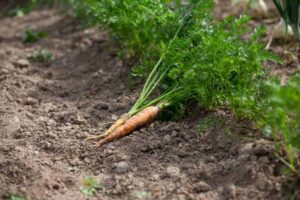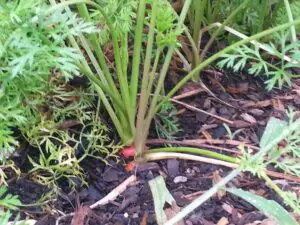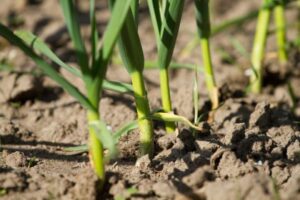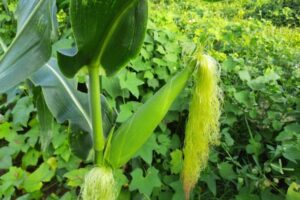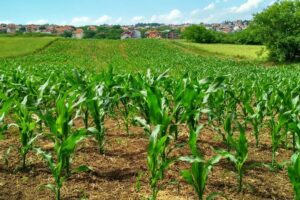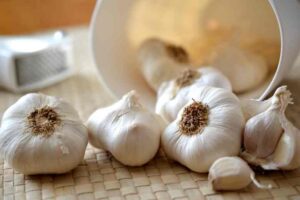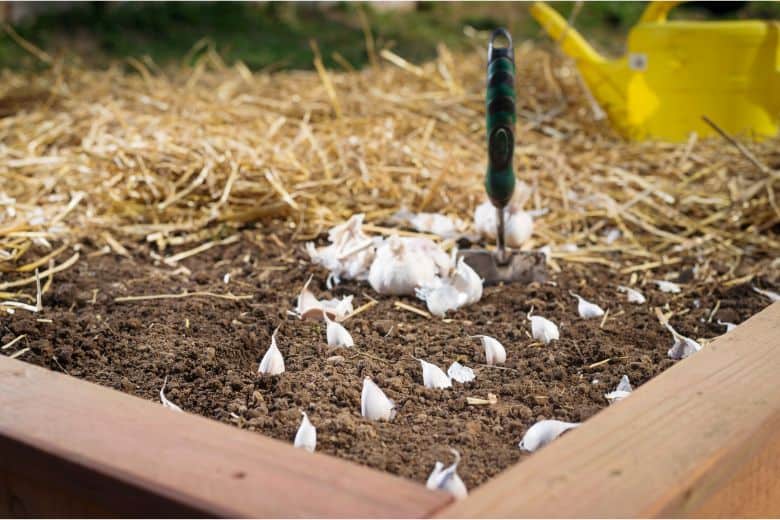
When it comes to planting garlic in New Hampshire, the best timing is usually between late September and early October. This is when the soil temperature is ideal for planting, and the garlic will have enough time to develop its roots and grow before the cold winter sets in.
To ensure the best results, it is recommended that garlic cloves be planted about 4 inches deep and 4 inches apart. If you are planting multiple rows of garlic, make sure that there is about 12-18 inches of space between the rows. With proper care and regular watering, the garlic should be ready to be harvested in mid-July.
Climate Considerations for Planting Garlic in New Hampshire
Here are some climate considerations for planting garlic in New Hampshire:
# Timing: The optimal time to plant garlic is in early-mid October. Cooler fall weather allows garlic to establish roots before dormancy. Planting too late risks freezing before roots are developed.
# Hardiness Zones: Most of NH is USDA zone 5, with northern parts zone 4. Softneck varieties like Persian Star are good choices as they’re hardy to zone 4.
# Soil: Garlic prefers well-draining, nutrient-rich soil with a neutral pH of around 6.5-7. Add compost before planting if the soil is poor.
# Sunlight: Garlic needs full sun and at least 6 hours per day of direct sunlight to bulb properly. Position beds accordingly.
# Watering: Provide 1-2 inches of water per week from planting through summer bulbing. Consistent moisture is key, but avoid overwatering.
# Mulching: Apply 2-3 inches of mulch-like straw after the ground freezes to insulate bulbs through winter.
# Varieties: In addition to the Persian Star, other cold-hardy varieties for NH include Music, Inchelium Red, and German White. Hardneck types like Rocambole may require winter mulch.
# Frost dates: Protect starts if frost is predicted before bulbs mature in late summer. Lifting and curing bulbs once foliage yellows ensures proper drying before storage.
Paying attention to these climate factors will help garlic thrive in New Hampshire’s cold weather zones. Proper planting and care result in healthy, flavorful, homegrown garlic.
Choosing the Best Garlic Varieties for Planting in New Hampshire
Choosing the right garlic variety for your garden is essential for successful growing. Knowing which varieties are best suited to the climate of New Hampshire will help you get the most out of your garlic crop.
The state’s climate suits garlic cultivation quite well, but the key to a successful harvest is to choose the right variety. Here are some of the best garlic varieties you might consider for planting in New Hampshire:
- ‘Music’: Music is a variety of hardneck garlic that does exceptionally well in cold climates. It has a rich, strong flavor and is very hardy, making it perfect for New Hampshire winters. Each bulb usually contains about 4-6 large cloves.
- ‘German Extra Hardy’: Also known as ‘Northern White’, this is another hardneck variety that’s well-suited to northern climates. It boasts large, robust bulbs that have a spicy flavor.
- ‘Russian Red’: If you’re looking for a garlic variety that’s spicy, strong, and robust, you might consider Russian Red. This is a hardneck variety, and it’s known for its resilience in cold weather.
- ‘Chesnok Red’: This hardneck variety is known for its excellent storage qualities and sweet, full-bodied taste when roasted. Chesnok Red is also highly resistant to diseases.
- ‘Inchelium Red’: This is a softneck variety that can also do well in New Hampshire’s climate. It’s not as winter-hardy as some of the hardneck varieties, but it’s known for its large, dense bulbs and mild flavor. It’s also a good choice if you plan to make garlic braids.
- ‘Spanish Roja’: An old favorite among gardeners, Spanish Roja is a hardneck variety known for its complex and spicy flavor. It’s a reliable performer in colder climates.
Before planting, it’s also crucial to consider a few other factors. Garlic should be planted in the fall, usually around Columbus Day, to give it a chance to establish roots before the deep freeze of winter. It also needs well-drained soil and full sun exposure.
Soil Preparation for Planting Garlic in New Hampshire
Soil preparation is a crucial part of growing garlic successfully, as this crop thrives in well-draining, nutrient-rich soil. Here are the steps to prepare your soil for planting garlic in New Hampshire:
- Choose the Right Location: Garlic needs full sun to grow well. The area should get at least 6 hours of direct sunlight each day. It also prefers well-draining soil, as garlic bulbs can rot if they sit in waterlogged soil.
- Test the Soil: Soil pH greatly impacts garlic growth. Garlic prefers a pH of 6.0 to 7.0. You can get your soil tested at a local extension office or use a home testing kit. If your soil is too acidic, you can add lime to raise the pH. If it’s too alkaline, add sulfur or peat moss to lower the pH.
- Clear the Bed: Remove any weeds or stones from your chosen garlic bed. Garlic doesn’t compete well with weeds, so starting with a clean bed will give your crops the best chance of success.
- Amend the Soil: If your soil is heavy clay or sandy, you’ll want to add plenty of organic matter to improve its structure and drainage. Compost or well-rotted manure works well. Incorporate 3 to 4 inches of organic matter into the top 6 to 8 inches of soil.
- Add Fertilizer: Garlic is a heavy feeder. At the time of planting, mix a slow-release, granular organic fertilizer into your soil. It should be high in nitrogen, which is essential for leaf growth. The more leaf growth, the larger the bulb.
- Prepare the Planting Beds: Break up any clumps and smooth out the surface. If your soil is particularly heavy or your area experiences a lot of rainfall, consider planting garlic in raised beds or ridges to ensure good drainage.
- Plant at the Right Time: In New Hampshire, garlic is typically planted in the fall, around Columbus Day. This allows the cloves to establish roots before winter arrives.
Planting Timing for Garlic in New Hampshire
When it comes to planting garlic in New Hampshire, timing is key. Planting garlic in the fall allows the bulbs to establish strong roots before the cold winter months.
In New Hampshire, as in most parts of the northern United States, garlic is usually planted in the fall. This allows the cloves to establish roots before the cold winter temperatures set in.
Here’s a breakdown of the timing for planting garlic in New Hampshire:
Late September to mid-October: This is typically the best time to plant garlic in New Hampshire. The aim is to give the cloves enough time to establish roots but not so much time that they start sending up green shoots before winter. The exact timing can vary depending on the specific weather patterns each year, but a good rule of thumb is to plant around Columbus Day.
Overwintering: Once planted, the garlic will go dormant over the winter. You might see some green shoots popping up if there’s a warm spell, but don’t worry – garlic is very hardy and can withstand winter temperatures.
Spring: When the weather warms up in spring, your garlic will begin actively growing again. You’ll see the green shoots starting to grow taller, and the garlic bulbs will start to form.
Summer: Garlic is typically ready to harvest in mid to late summer, usually in July or August in New Hampshire. You’ll know it’s time to harvest when the lower leaves start to turn brown while around half the upper leaves are still green.
Remember, it’s important to plant garlic cloves with the pointy end facing up and the flat root end facing down. Plant them about 2 inches deep and 4-6 inches apart. After planting, cover the bed with a thick layer of straw or mulch to protect the cloves over the winter and help conserve moisture.
Aftercare for Garlic Plantings in New Hampshire
After planting garlic in the fall in New Hampshire, there are several things you need to do to ensure a healthy crop:
- Mulching: After planting, cover the bed with a thick layer of straw or mulch. This helps to protect the garlic from the harsh winter temperatures, conserve soil moisture, and suppress weed growth.
- Watering: Garlic needs about an inch of water each week during the growing season, either from rain or irrigation. Be careful not to overwater, as garlic does not like waterlogged soil. The watering need decreases as the bulbs mature and the weather warms up. Stop watering entirely once the garlic leaves begin to turn yellow and fall over, usually a few weeks before harvest.
- Fertilizing: In the spring, once the ground has thawed and your garlic begins to sprout, apply a high-nitrogen fertilizer to encourage strong leaf growth. The size of the garlic bulb is directly related to the size and number of the leaves at the time of bulb formation.
- Weeding: Keep the garlic bed free of weeds, as garlic does not compete well with them. Weeds can stunt the growth of your garlic plants and can also harbor pests and diseases.
- Scapes: If you’re growing hardneck garlic varieties, they’ll produce a flower stalk, known as a scape, in late spring or early summer. Snip these off when they start to curl. This allows the plant to focus its energy on bulb production instead of flowering. Don’t throw the scapes away – they’re delicious to eat!
- Pests and Diseases: Keep an eye out for pests like thrips and diseases such as white rot and botrytis rot. Rotate your crops to prevent the buildup of disease, and avoid planting garlic in the same location where onions, leeks, or other alliums have been grown in the past two years.
- Harvesting: Harvest the garlic when several of the lower leaves have browned but about half of the upper leaves are still green. This is usually in mid to late summer in New Hampshire. Be careful not to wait too long, as the bulbs can split open if left in the ground too long.
Frequently Asked Questions
What is the optimal time for planting garlic in New Hampshire?
Answer: The optimal time for planting garlic in New Hampshire is usually late September to mid-October.
How long does it take for garlic to grow in New Hampshire?
Answer: Garlic typically takes 8-10 months to reach maturity in New Hampshire.
How much water does garlic need when planted in New Hampshire?
Answer: Garlic needs 1-2 inches of water per week when planted in New Hampshire.
Conclusion
Overall, planting garlic in New Hampshire is a great way to enjoy homegrown garlic in the summer. Planting it in the fall will give you the best results, as it needs the cold winter months to reach full maturity. Garlic likes to be planted in well-drained, compost-enriched soil and should be spaced around 6 inches apart. With the right care, you can enjoy a bumper crop of garlic in the summer.

